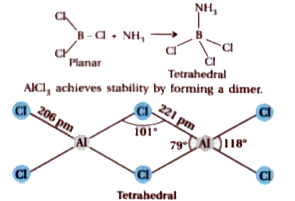Give chemical properties of elements of group-13.
Due to small size of boron, the sum of its first three ionization enthalpies is very high. This prevents it to form +3 ions and forces it to form only covalent compounds.
But as we move from B to AI, the sum of the first three ionisation enthalpies of Al considerably decreases and is therefore able to form Al3+ ions. In fact, aluminium is a highly electro-positive metal.
However, down the group, due to poor shielding effect of intervening d and f orbitals, the increased effective nuclear charge holds ns electrons tightly (responsible for inert pair effect) and there by, restricting their participation in bonding.
As a result of this, only p-orbital electron may be involved in bonding. In fact in Ga, In and Tl, both +1 and +3 oxidation states are observed.
The relative stability of +1 oxidation state progressively increases for heavier elements : Al < Ga < In < TI.
In thallium +1 oxidation state is predominant where as the +3 oxidation state is highly oxidising in character.The compounds in +1 oxidation state, as expected from energy considerations, are more ionic than those in +3 oxidation state.
In trivalent state, the number of electrons around the central atom in a molecule of the compounds of these elements (e.g., boron in BF3) will be only six. Such electron deficient molecules have tendency to accept a pair of electrons to achieve stable electronic configuration and thus, behave as Lewis acids. The tendency to behave as Lewis acid decreases with the increase in the size down the group. BCl3 easily accepts a lone pair of electrons from ammonia to form BCl3⋅NH3.

In trivalent state most of the compounds being covalent are hydrolysed in water. For example, the trichlorides on -hyrolysis in water form tetrahedral [M(OH)4] species, the hybridisation state of element M is sp3.
Aluminium chloride in acidified aqueous solution forms octahedral [Al(H2O6]3+ ion. In this complex ion the 3d orbitals of Al are involved and the hybridisation state of Al is sp3d2.
(i)Reactivity towards air :
Boron is unreactive in crystalline form.
Aluminium forms a very thin oxide layer on the surface which protects the metal from further attack.
Amorphous boron and aluminium metal on heating in air form B2O3 and Al2O3 respectively. With dinitrogen at high temperature they form nitrides.
2E(s)+3O2(g)Δ−−→2E2O3(s)
2E(s)+N2(g)Δ−−→2EN(s) (E=Elements)
The nature of these oxides varies down the group. Boron trioxide is acidic and reacts with basic (metallic) oxides forming metal borates.
Aluminium and gallium oxides are amphoteric and those of indium and thallium are basic in their properties.
(ii) Reactivity towards acids and alkalies : Boron does not react with acids and alkalies even at moderate temperature, but aluminium dissolves in mineral acids and aqueous alkalis and thus shows amphoteric character. Aluminium dissolves in dilute HCl and liberates dihydrogen.
2Al(s)+6HCl(aq)→2Al3+(aq)+6Cl−(aq)+3H2(g)
However, concentrated nitric acid renders aluminium passive by forming a protective oxide layer on the surface. Aluminium also reacts with aqueous alkali and liberates dihydrogen.
2Al(s)+2NaOH(aq)+6H2O(l) ⏐↓2Na+[Al(OH)4]−aq+3H2(g)Sodium tetrahydroxoaluminate (III)
(iii) Reactivity towards halogens : These elements react with halogens to form trihalides (except Tl I3)
2E(s)+3X2(g)→2EX3(s) (X=F,Cl,Br,I)
Related Playlists
- BOOK - KUMAR PRAKASHANCHAPTER - THE P-BLOCK ELEMENTSEXERCISE - SECTION-B OBJECTIVE QUESTIONS (SHORT QUESTIONS)56videos
THE P-BLOCK ELEMENTS
- BOOK - KUMAR PRAKASHANCHAPTER - THE P-BLOCK ELEMENTSEXERCISE - SECTION-B OBJECTIVE QUESTIONS (TRUE/FALSE)6videos
THE P-BLOCK ELEMENTS
- BOOK - KUMAR PRAKASHANCHAPTER - STRUCTURE OF ATOMEXERCISE - QUESTINS PAPER FROM MODULE (SECTION -D)2videos
STRUCTURE OF ATOM
- BOOK - KUMAR PRAKASHANCHAPTER - THE s-BLOCK ELEMENTSEXERCISE - Section-D NCERT Exemplar Solution (Long Answer Type)8videos
THE s-BLOCK ELEMENTS
Similar Practice Problems
- Question 1 - Select One
Assertion: Elements belonging to the same group show similarity in chemical properties.
Reason: Elements of the same group have same number of valence electrons.ABoth A and R are true and R is correction explanation of the assertion.BBoth A and R are true and R is not the correct explanation of the assertionCA is true but R is falseDA is false but R is true
Similar Questions
Give scientific reasons.
The chemical reactivity of elements of group 1 increases downwards, whereas that of elements of group 17 decreases.View SolutionWhy are the chemical properties of the elements
belonging to the same group similar?View SolutionCompare the general trend in the following properties of the elements of group 13 and 14 :
Ionisation enthalpy,View SolutionCompare the general trend in the following properties of the elements of group 13 and 14 :
Metallic character,View SolutionCompare the general trend in the following properties of the elements of group 13 and 14 :
Nature of halides.View SolutionCompare the general trend in the following properties of the elements of group 13 and 14 :
Oxidation states,View SolutionCompare the general trend in the following properties of the elements of group 13 and 14 :
Atomic size,View SolutionChemical Properties of Group 15
View SolutionName the property which all the elements of group 13 have in common.
View Solution

